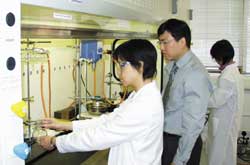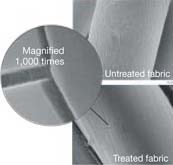
Golfers and
other outdoor people will soon be wearing sportsclothes coated with
a sun-blocking skin developed by researchers at The Hong Kong Polytechnic
University.
 The
nanoscale layer, made up of hybrid polymers and monomers, is presently
the subject of a US patent application. Originally supported by
a RGC grant, further funding came from the Innovation Technology
Fund when the research’s potential became clearer. The
nanoscale layer, made up of hybrid polymers and monomers, is presently
the subject of a US patent application. Originally supported by
a RGC grant, further funding came from the Innovation Technology
Fund when the research’s potential became clearer.
 |

|
| Left:
Dr Xin oversees the mix of materials. Right: Fabric without
and with the sun-block layer. |
 The
chemical layer, which can be applied to textiles using an inexpensive
conventional dip-and-squeeze process, is less than 100 nanometres
thick, about 0.0001 mm. It acts like a shield against harmful ultraviolet
sunlight, dramatically reducing the risks of sunburn, premature
skin ageing, and skin cancer. The
chemical layer, which can be applied to textiles using an inexpensive
conventional dip-and-squeeze process, is less than 100 nanometres
thick, about 0.0001 mm. It acts like a shield against harmful ultraviolet
sunlight, dramatically reducing the risks of sunburn, premature
skin ageing, and skin cancer.
 Compared
to untreated fabric, the layer gives more than five times better
protection, said Principal Investigator Dr John Xin of PolyU’s
Institute of Textiles and Clothing. And after 55 washes, the treated
fabric still has strong UV-absorbing qualities so is considered
permanent, he added. Compared
to untreated fabric, the layer gives more than five times better
protection, said Principal Investigator Dr John Xin of PolyU’s
Institute of Textiles and Clothing. And after 55 washes, the treated
fabric still has strong UV-absorbing qualities so is considered
permanent, he added.
 His
research is now moving on to nanoscale stain-repelling and anti-microbial
finishes. His
research is now moving on to nanoscale stain-repelling and anti-microbial
finishes.
Principal
Investigator
Dr John Xin : tcxinjh@inet.polyu.edu.hk

|


